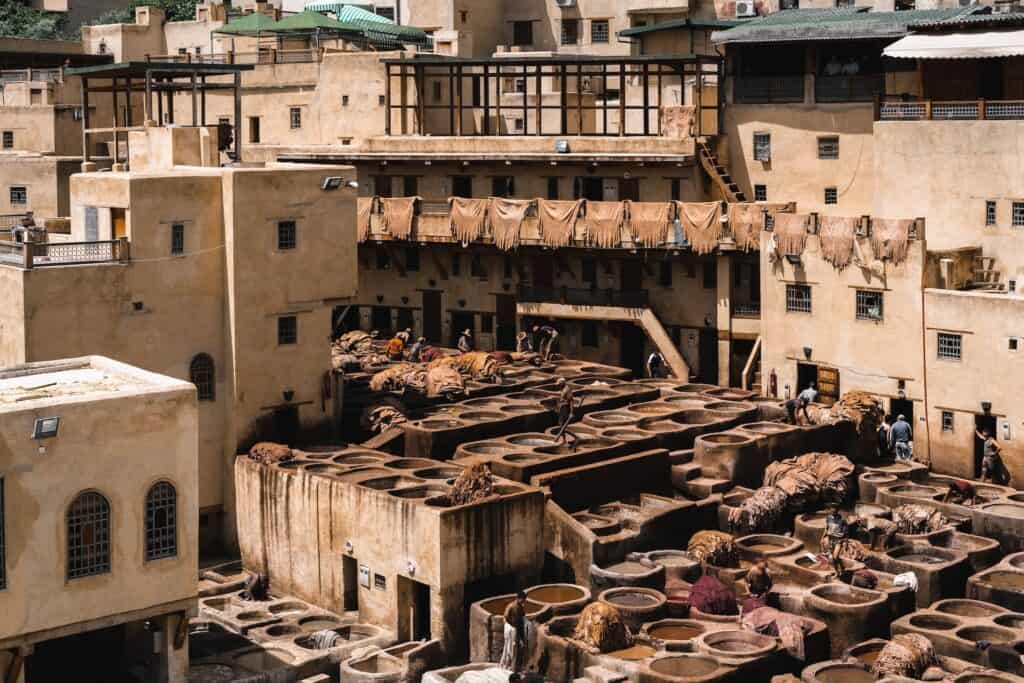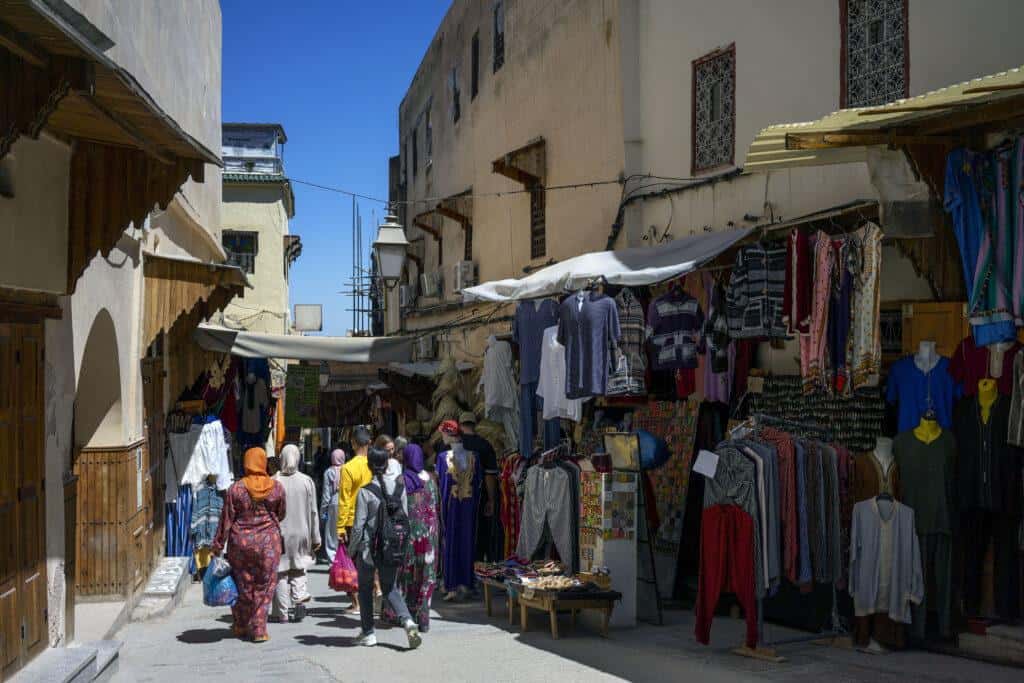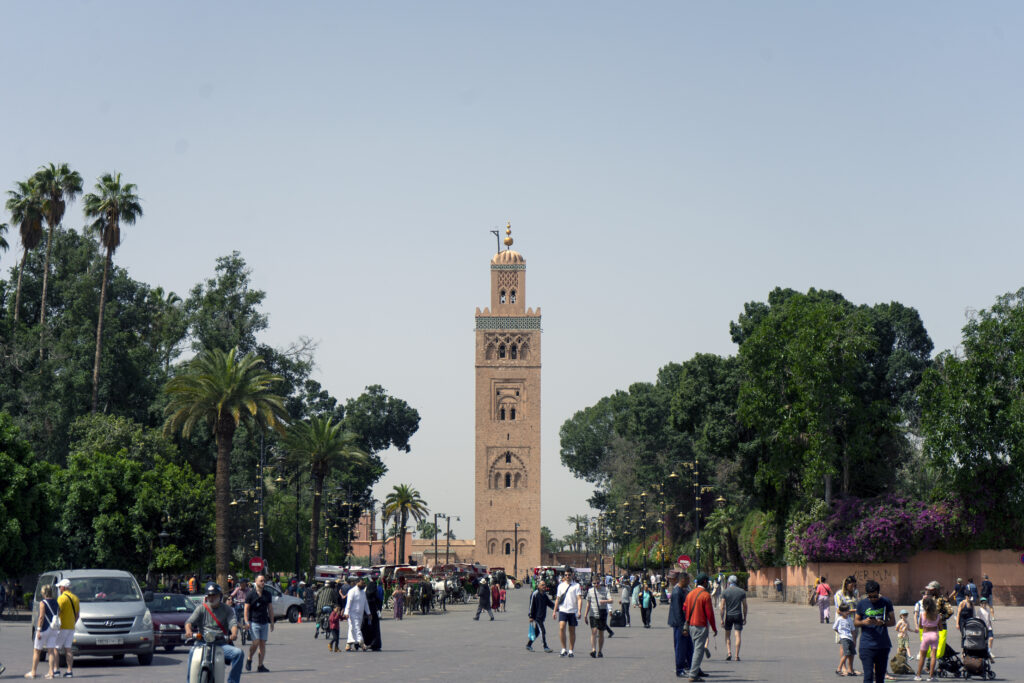Chefchaouen is a small city in the Rif Mountains, in the north-west region of Morocco. Chefchaouen became known as “the Blue Pearl of Morocco” because the buildings, streets, gardens, and walls of the old medina are painted blue.
With 24 hours in Chefchaouen, you’ll have just enough time to enjoy this city’s incredible aesthetic, visit some of Chefchaouen’s main sites, and relax. Because Chefchaouen’s blue medina is small, you can see quite a lot within 24 hours.
This city has a unique aesthetic, interesting history, and a very relaxed vibe. This is exactly why I myself have visited Chefchaouen twice!
Disclosure: This article includes affiliate links. This means that if you make a purchase through one of those links, I earn a small commission. Affiliate links cost you nothing to use, and keep Pina Travels reader-supported. Thank you!

Why Chefchaouen is Painted Blue
Chefchaouen is known as the Blue Pearl of Morocco because of its narrow streets and buildings which are painted in many shades of blue. Many people, including myself, travel to Chefchaouen for this alone.
There’s several reasons that intersect to explain why this city is painted blue. The most popular theory is that it all started after the second world war, when the Jewish community in the area grew as people fled Nazi persecution.
Some suggest that blue was painted on the walls, floors, and steps as a religious practice, since blue is a sacred color in Judaism.
Another theory suggests that the blue paint is made of a mixture of lime and something like indigo or blue dye. It’s believed by some that this mixture repels mosquitoes and can help keep buildings cooler during the summer heat.
The final theory is pretty simple! Over time, the distinctive blue buildings have become a major draw for tourists. People love the unique aesthetic of the blue medina (old town), and it’s helped make Chefchaouen a popular city to visit.
These days, locals continue to paint the medina blue to maintain the city’s aesthetic appeal and ensure it holds on to its identity as the “Blue Pearl” or “Blue City.”

How Long Should You Spend in Chefchaouen?
Chefchaouen’s blue medina is small, and so 24 hours in Chefchaouen is enough time to experience it, and see the main sites of the old town. However, for a more in-depth experience, stay at least 2 days. With longer in Chefchaouen, you’re able to take your time, and fit in some activities beyond the blue medina – like hiking in the nearby Rif Mountains.
How to Get to Chefchaouen
To spend 24 hours in Chefchaouen, you’ll need to first transfer there. Most people travel to Chefchaouen from either Fes or Tangier, and the most common ways to travel between these cities is by car, or by bus.
On both my trips to Chefchaouen, I went by public bus from Fes to Chefchaouen and back. The bus was super easy. Luggage is stored underneath, and I found the seats, which are assigned, very comfortable. And, there’s AC!
How to Get to Chefchaouen From Fes By Car
The most common route is to take the N13, which leads directly from Fes to Chefchaouen. It’s about a 4-5 hour drive, covering approximately 200 kilometers (124 miles).
You’ll depart Fes and head west on the N13 road toward Taza. Continue on the N13, passing through various towns like Taza and Ouazzane, until you reach Chefchaouen.
- Need a car rental for your Chefchaouen adventures? Discover Cars compares the prices for a vehicle from a variety of suppliers to ensure you get the cheapest rate, and you can reserve your car rental in advance. Reserve a car rental here!
How to Get to Chefchaouen From Fes By Bus
There are several bus companies that operate between Fes and Chefchaouen, and there’s a couple departures throughout the day. The trip takes about 4.5 hours each way.
You’re most likely to go by CTM bus. CTM is a popular bus company in Morocco that provides comfortable and reliable service. You can check their schedules and book tickets in advance online through the CTM website, or at the CTM bus station in Fes.

How to Get to Chefchaouen From Tangier By Car
The distance between Tangier and Chefchaouen is approximately 120 kilometers (75 miles. It takes 2-3 hours to drive the route by car.
You’ll leave Tangier heading south on the N2 or take the A4 highway towards Tetouan. From Tetouan, follow signs or maps to connect to the R408 road leading to Chefchaouen.
- Need a car rental for your Chefchaouen adventures? Discover Cars compares the prices for a vehicle from a variety of suppliers to ensure you get the cheapest rate, and you can reserve your car rental in advance. Reserve a car rental here!
How to Get to Chefchaouen From Tangier By Bus
There is a direct CTM bus from Tangier to Chefchaouen. The bus runs several times a day, every day. The journey takes approximately 2.5 hours. You can check the schedules and book tickets in advance online through the CTM website, or at the CTM bus station in Tangier.

Where to Stay in Chefchaouen
With 24 hours in Chefchaouen, you’ll need a place to stay for the night. I recommend staying in the old medina. It’s convenient, and means you can enjoy an evening and morning stroll through Chefchaouen’s beautiful blue streets.
Here are some highly rated Chefchaouen hotels to consider staying in:
Casa Sabila
Casa Sabila is a small hotel in a historic building with beautiful architecture. It has a rooftop terrace that overlooks the city, where you’ll enjoy a delicious breakfast every morning.
Casa Sabila is located in a convenient part of the old medina, within walking distance of all the main sites to see. This hotel has single, double, and triple rooms, and has all the key amenities you need, including WiFi.
Puerta Azul
Puerta Azul is a medium-sized hotel known for its colorful rooms – many of which are painted with blue accents to match the city. There’s a range of rooms to choose from, including double, triple, and family rooms.
The rooms at Puerta Azul have a balcony or patio, free WiFi, a flat-screen TV, as well as a communal lounge. Breakfast is available every morning and includes continental, vegetarian or vegan options. Puerto Azul is conveniently located within the old medina.
Casa Perleta
Casa Perleta is another quaint, colorful hotel in the old medina of Chefchaouen. This highly-rated hotel has a variety of rooms, including double, triple, and family rooms.
This hotel is traditionally decorated and has a beautiful terrace. Casa Perleta has a 24-hour reception desk, WiFi, and a continental breakfast is served at the accommodation every morning.

24 Hours in Chefchaouen: 7 Best Things to Do
With 24 hours in Chefchaouen you’ll have just enough time to see the old medina and some of Chechaouen’s most important sites. Because the old medina is small, you’re able to walk everywhere.
Below are 7 of the best things to do in Chefchaouen during your 24-hour visit.
1. Wander Chefchaouen’s Medina
One of the best things to do in Chefchaouen is simply wander the old medina. Take at least a few hours to slowly make your way around, admiring the blue buildings and popping into shops. If you’re like me, you’ll also appreciate all the cute and friendly cats that live in the medina!
Compared to the medinas of other cities in Morocco, like Marrakech and Fes, Chefchaouen’s medina is very quiet. This makes it super relaxing to wander.
For the best experience (and people-free photos) in Chefchaouen’s medina, wake up early to go walking before the midday crowds arrive. I found that going out at 7am to 8am was the perfect time for getting those iconic Blue City photos.
One thing to note about taking photos is how important it is to be respectful. Local people live in this medina, and inside the iconic blue buildings of Chefchaouen. Don’t trespass for photos, and be prepared to pay a fee in some doorways and alleys.
In Chefchaouen, follow responsible tourist practices. An important one of these practices is be very cognizant of accidentally photographing local people.
Some people do not want to be photographed for religious reasons. When taking photos of streets or alleys in the medina, be aware of who might end up in the frame. If you can, wait a moment until local people are out of the frame before snapping the image.
If you would like to take a photo of a person, be sure to ask for their consent. If you intend to share a photo of someone to your social media, or any public platform, it’s important to have explicit consent to do so.

2. Have Lunch in Uta el-Hamman Square
Uta el-Hamman Square is in the center of Chefchaouen. It’s an open square, surrounded by the city’s famous blue-washed buildings, markets, artisan shops, cafes, and restaurants.
This is a bit of a touristy area, but it’s worth sitting to have coffee or a meal while taking in the views. For a great meal in the square, go to Bilmos. This restaurant has lots of menu options to choose from, including vegetarian and vegan options. The avocado salad is delicious!
It’s worth dropping by Uta el-Hamman Square during the day, and in the evening. During the day you have a beautiful view of the terraced houses of the old town, Chefchaouen’s Kasbah, and hills in the distance. In the evening, you can enjoy the local buskers who perform in the square.

3. Visit the Kasbah Museum
The Kasbah of Chefchaouen is a historic fortress that dates back to the 15th century. This clay-brown fortress is home to a beautiful Andalusian-style garden, a former prison, the small Center for Research and Andalusian Studies and a small art gallery.
In the Kasbah’s museum you can learn about key elements of Moroccan heritage such as typical musical instruments, pottery, sculptures, embroidery and weapons that would have been used to defend the fortress.
4. Walk to Lavadero de la Ciudad
A short walk from the Bab El Onsar medina gate is an area called Lavadero de la Ciudad (which translates loosely to “city laundry”). In this area just on the outskirts of the medina, there’s a small river that flows down from nearby hills.
This was once where locals came to wash their clothing and textiles in the river. These days, you aren’t as likely to see that, but it’s a lovely area to walk around.
There are stands where you can buy fresh-squeezed juice from a vendor, and restaurants that overlook the river. Some of the restaurants and cafes set up tables right on the banks of the river, so you can dip your feet into the water on a hot day.

5. Visit the Souk (Market)
If you happen to be in Chefchaouen on a Monday or a Thursday, visit the local souk. Souk is the Moroccan word for market. The Chefchaouen souk takes place on the outskirts of the old medina.
There you’ll find people who’ve come in from the surrounding areas to sell their produce and goods, like clothing and leather products. If you’re looking to buy locally made goods, the souk is a great place to do your shopping.
6. Taste Local Goat Cheese
The Blue City of Morocco is known for its goat cheese. Jben is a traditional Moroccan goat cheese made from pure goat milk.
It’s a rounded traditional cheese that is emblematic of the Chefchaouen region, and a staple in northern Moroccan cuisine. In Chefchaouen and other parts of Morocco too, you’ll find this creamy cheese included often with breakfast.

7. Take in the View From the Spanish Mosque
The Spanish Mosque, which is called Mosque Jemma Bouzafar by locals, was built in the mid 1920s. It’s known as the Spanish Mosque because it was built during the Spanish colonial rule of the region.
In 2007, the mosque was repaired after having fallen into disrepair. These days, it’s a popular viewpoint in Chefchaouen, because it’s up on a hill overlooking the city. While the view from the Spanish Mosque is gorgeous all day long, sunrise and sunset are particularly nice times to head up there.
The best way to get to the Spanish Mosque is to walk. It takes 30 to 45 minutes to walk to the mosque, each direction. The trail starts at the Bab El Onsar Gate, where you’ll start walking a paved trail up toward the mosque.
Final Thoughts: Is 24 Hours in Chefchaouen Worth It?
Yes, 24 hours in Chefchaouen is absolutely worth it. With one full day, you can fit in all the highlights of this beautiful blue city. Enjoy a walk through the old medina, visit the Kasbah, watch the sunset from the Spanish Mosque, and have breakfast on your hotel’s terrace.
More from Pina Travels on Morocco:
- What Not to Do in Fes, Morocco: 13 Fes Tips
- 10 Reasons to Visit Morocco in Winter
- 3 Best Sahara Desert Tours From Marrakech (+ What to Expect)
- How to Visit Bhalil, Morocco (2023 Guide)
Erin has been traveling for over a decade, both solo, and with her partner. She’s now traveled to countries across 6 continents, and has lived in 2 countries abroad. Erin also hosts the travel podcast, Curious Tourism, where she interviews travel industry thought leaders and experts about responsible tourism. Learn more about Erin, and get in touch with her, here.




